Back Posture – The Future Of Your Back & Relief Of Pain Depends On It
With a basic knowledge of low back pain we can see if the back loses the normal forward curve, it is vulnerable to injury and ligament damage from overstretching. This is commonly seen with poor sitting posture and activities in which one is bent forward. Since your nerves are behind your disc, bending forward usually squeezes the disc causing a bulging of the disc towards the nerves causing pain syndromes in the lumbar spine.
This can lead to a herniation of the disc in the lower back, acute pain like sciatica and may lead to early disc degeneration. Therefore, it is important to avoid slouching or slumping forward when sitting, standing or bending when sitting, lifting or lounging.
Damaging Effects Of Bad Back Posture
 The protective nature of the disc is lost as the low back is bent forward and the soft inner portion of the disc is pushed to the back. With weakened or damaged ligaments, the disc can bulge, protrude or even herniate to put pressure on the nerves. Loss of the forward curve places abnormal biomechanical stress on the vertebra creating instability. It is this unstable structure that causes much of the premature arthritis seen on x-rays as the body attempts to stabilize the region by forming bony bridges around the joints. An advanced form of this process can be seen with the unstable nature of Modic changes in the spine and the relationship to chronic, disabling back pain conditions.
The protective nature of the disc is lost as the low back is bent forward and the soft inner portion of the disc is pushed to the back. With weakened or damaged ligaments, the disc can bulge, protrude or even herniate to put pressure on the nerves. Loss of the forward curve places abnormal biomechanical stress on the vertebra creating instability. It is this unstable structure that causes much of the premature arthritis seen on x-rays as the body attempts to stabilize the region by forming bony bridges around the joints. An advanced form of this process can be seen with the unstable nature of Modic changes in the spine and the relationship to chronic, disabling back pain conditions.
- In chronic low back problems there is a noted association between pain and loss of the normal forward curve. A 1998 study in the Journal of Spinal Disorders regarding lumbar lordosis discrimination between normal and lower back pain subjects found chronic low back pain shows a significant average decrease in the forward curve by over 10 degrees! This is related to slumped posture sitting and reclining.
- A 2015 study in Journal of Physical Therapy Science investigated body discomfort and muscle activity in three sitting postures with electromyography. The authors found that leaning forward was the sitting posture with the greatest low back discomfort. Sitting straight provided the best comfort and muscle balance compared to forward leaning and slumped postures. This helps protect the passive structures like ligaments, discs and joints from damage.
The most common cause of lower back pain is postural stress. This type of pain is often brought on by sitting for a long time in a poor position, poor lifting technique, frequent forward bending in working positions, standing or lying for a long time in poor back posture. All of these positions place the back under stress by reducing the normal curve of the back (lordosis), allowing the ligaments to over stretch, muscles to strain and the discs to become stressed.
Unfortunately, many of us spend most of our work and/or leisure time with the lower back in this flexed (forward bent) posture position and completely lose the normal curve (lordosis) of the back, sometimes called hypolordosis. As time passes, this posture causes changes to the structure and shape of the joints as excessive wear and loss of flexibility results in premature ageing of the back resulting in chronic pain. The bent, stooped posture often seen in the elderly are visible consequences of a lifetime of poor postural habits. This bent position affects more than just the lower back as the lungs become constricted and internal organs are deprived of the correct support.
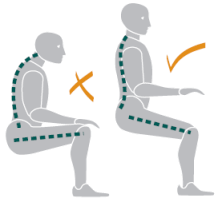 Poor sitting posture commonly produces lower back pain, and once back problems have developed, a poor sitting posture can promote and worsen the problem. Due to our ever increasing sedentary lifestyles, poor posture is a widespread problem. When we sit for prolonged periods, the muscles that support the low back begin to weaken and, as they relax, the body sags into a slouched position which, when maintained for long periods of time, the ligaments become overstretched, discs become distorted and lower back pain results.
Poor sitting posture commonly produces lower back pain, and once back problems have developed, a poor sitting posture can promote and worsen the problem. Due to our ever increasing sedentary lifestyles, poor posture is a widespread problem. When we sit for prolonged periods, the muscles that support the low back begin to weaken and, as they relax, the body sags into a slouched position which, when maintained for long periods of time, the ligaments become overstretched, discs become distorted and lower back pain results.
This condition then produces pain during movement as well. Correct sitting posture is very important after vigorous activity like jogging or tennis because exercised joints easily distort if placed in a slouched position. Often the back pain is blamed on the physical activity, when it is the posture assumed when relaxing afterwards that causes the problem.
For years, many people have had the habit of sitting in a bad posture without low back pain, however, once lower back problems have developed, sitting in a poor position will perpetuate and worsen the problem. It is essential that the lordosis (normal curve) of the lower back is maintained at all times. This requires effort and repeated long enough to make it habit or, as I like to call it, an acquired skill. This should be done slowly and not with jerky motions or with excessive force. This should be started early in life.
- A 2015 study in the European Spine Journal found a direct relationship between low back pain and poor lumbar spine posture in high school students. Bad back posture was associated with watching Television, using computers and playing video games at home. The authors noted a “high prevalence” and “substantial impact” on back pain resulting from early bad posture habits. They noted nearly a 50% increase in chronic low back pain with slumped postures.
- Asian Spine J. 2014 noted lessening of the lumbar curve as in slumped postures is associated with degenerative disc disease. The authors dilemma was which comes first, disc disease or loss of the lumbar postural curve; however, there tends to be a postural relationship with poor posture and disc problems.
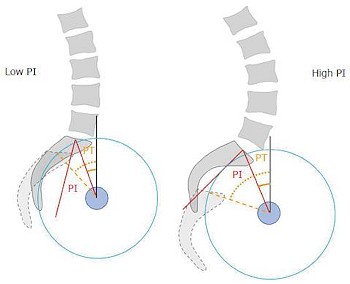
- A 2010 study in the European Spine Journal indicates loss of the normal curve is associated with disc herniation. While a 2017 study in the Spine Journal found a strong relationship between low back pain from disc herniation and degenerative disc disease with loss of the normal curve.
- A 2016 study in the journal Spine demonstrated a significant association between loss of the normal lower back curve and early onset of spinal degeneration. The authors used MRI and found flat back posture in young adults was specifically associated with disc degeneration at the L4/L5 level of the lumbar spine.
- A 2017 systematic review and meta-analysis in The Spine Journal demonstrated a “strong relationship” between low back pain and decreased lumbar curve, with a “substantial” association with disc herniation and degeneration.
- A 2019 study in the Journal of Orthopaedic Surgery and Research found that loss of lumbar lordosis and a more horizontal sacrum indicated a disharmonious spinopelvic interaction and a change in the compensatory model in patients with lumbar disc herniation
- A 2019 study in the journal Clinical Spine Surgery found that low back pain was associated with a decreased curve of the lumbar spine when standing in middle-aged and elderly women. When lying face down, there was a significantly higher stiffness in the lumbar multifidus muscle.
- A 2019 study in Spine found those with marked stooped posture had a negative effect on health related quality of life. Contributing factors in the lumbar spine were previous compression fracture, however, the authors indicated that high levels of intervertebral disc degeneration, particularly L5/S1, and quality and quantity of paraspinal muscles contribute synergistically to the progression of marked postural deformity.
- A 2010 study in Manual Therapy found that increased flexion (decreased lordosis) of the lumbar spine as in slumped sitting was associated with increased muscle activation of erector spinae muscles of the neck and greater head/neck flexion and anterior translation of the head or forward head posture.
The loss of the curve leads to postural distortions that cause muscle stiffness and pose a risk of early degenerative conditions. The lordotic back exercises seek to reverse this distortion and specifically treat compressive pain like disc herniations.
- A 2020 study in the Medical Science Monitor found that spinopelvic parameter, specifically pelvic incidence (PI) is associated with Modic changes. They found a smaller incidence, associated with loss of the curve, is associated with a higher incidence of degenerative Modic changes.
 This indicates lumbar instability, especially of the of L5/S1 and increased weight bearing of the disc endplate, which is particularly sensitive to increased loading and can result in deformation of the endplate and spinal bone, resulting in Modic changes of the lumbar spine. These changes are highly associated with pain, inflammation, fatty degeneration, and sclerosis.
This indicates lumbar instability, especially of the of L5/S1 and increased weight bearing of the disc endplate, which is particularly sensitive to increased loading and can result in deformation of the endplate and spinal bone, resulting in Modic changes of the lumbar spine. These changes are highly associated with pain, inflammation, fatty degeneration, and sclerosis.
- A 2020 study in JOR Spine found a lower pelvic incidence was associated not only with Modic changes, but also disc displacement and UTE Disc Sign on MRI, which is associated with back pain, sciatica, degeneration, and disability.
- A 2021 study in the Global Spine Journal found that imbalance between the spine and the pelvis called poor spinopelvic harmony leads to unstable standing balance. This was based on the pelvic incidence and lumbar lordosis defining a “cone of economy” where unharmonious spinopelvic balance had a non-economic effect on standing.
- A 2018 study in Osteoarthritis & Cartilage indicates inclination of the spine when standing position and restricted lumbar spine mobility are significantly associated with progression of hip osteoarthritis. Indicating spinal alignment and mobility should be considered when assessing risk and formulating preventive measures for progression of hip osteoarthritis.
- A 2005 study in Spine found alignment of the lumbar spine and pelvis with back pain contributes to hip osteoarthritis in what is termed hip-spine syndrome.
Improving Back Posture
Make sure you are aware and practice correct core breathing technique. You should not do this in a chair with a stiff back. Practice using a backless stool or sitting forward in your chair. Begin by sitting and breathe out as you move forward in a slouched position with your body at 2:00, breathe in as you extend up and backward to 11:00, then exhale as you come forward to 12:00 maintaining the forward curve in your lower back and rest for a couple of breathing cycles.
It is the 12:00 position that is the normal sitting posture where the lordosis is maintained. This requires your own muscular effort and attention and you cannot fully relax. Without proper back support, you must sit this way. The sitting exercise should be done three times per day (morning, noon and evening) and whenever you experience pain as a result of poor seating.
Most chairs or seats do not provide proper support for the lower back. Fortunately, there are a number of good back supports available to fit most seating arrangements. Portable low back supports are essential for people with ongoing low back problems and when seated in a chair with a back, can promote the maintenance of correct posture.
For seats with or without an ergonomic back rest, back support pillows and specially designed seat cushions can keep better posture and the muscles of the back more relaxed. If you have chronic back problems with significant degeneration, the muscles of the back take over some of the function of the ligaments. This can lead to early fatigue and back muscle strain.
- A 2020 study in the Journal of Physical Therapy Science shows that extension traction methods like the home back traction increases the proper lumbar curve. Additionally, it can provide longer term relief for low back disorders compared to the conventional rehabilitation approaches tested.
Tips For Improvement
 Just as muscles tire and relax when we sit, some people get lower back pain when standing for long periods. Poor standing posture can result in an excessive curve opposite that of poor sitting posture. This allows the low back to hang in an extreme position. This posture is one of sagging chest and protruding abdomen. To correct this, you must hold your low back in a position of reduced curve (lordosis).
Just as muscles tire and relax when we sit, some people get lower back pain when standing for long periods. Poor standing posture can result in an excessive curve opposite that of poor sitting posture. This allows the low back to hang in an extreme position. This posture is one of sagging chest and protruding abdomen. To correct this, you must hold your low back in a position of reduced curve (lordosis).
Stand as tall as you can, lift the chest up, pull in your stomach muscles and tighten your buttocks. This is difficult at first, but practice in this new position will lead to more endurance and you will be able to maintain it for longer and longer periods. Remember to breathe correctly and this new position will strengthen the muscles around the back and help to reduce standing postural lower back pain.
A 2015 study in the journal Human Movement Science indicates that pain can result from prolonged standing. A strategy used to decrease the pain is to shift the weight from one foot to another and to change the posture of the lower back by moving it forward and backward slightly. These posture changes early on when standing help to avoid static stress on the lumbar spine and ground force reactions. So, transferring body weight and changing the center of pressure front to back are motions that can help. Rocker shoes can help.
Working in a bent over position causes considerable stress on the ligaments and discs of the lower back. Working around the house: gardening, sweeping, digging, making a bed, vacuuming, along with occupations such as; plumbers, carpenters, bricklayers, assembly line workers, mechanics, ect. require working in bent positions and are more likely to sustain back problems. Since the discs swell with fluids when you sleep and are non weight bearing, you are more likely to suffer back problems in the early hours, so special attention should be paid to your back in the morning and to reduce bending at this time.
Working when bending over frequently should be accompanied by frequent breaks to perform standing extension exercise. Similarly, coughing and sneezing cause significant stress in the discs and you should not bend over to cough or sneeze, in fact, you should stand and lead back slightly or if you cannot stand, assume correct posture with the normal curve in your lower back to help protect it.
Lifting objects with your back rounded and bent over places significant stress on the discs of the lower back. It is imperative to follow safe lifting habits at all times. If you use incorrect lifting technique with a heavy object, you may cause damage and sudden and severe back pain. As stated previous, lifting is more risky early in the day than latter, so plan accordingly. While lifting, you must retain the normal curve or arch in the back. Avoid using the back in a crane like motion. Use your legs to power the lift.
Stand up and bend backward a few times after lifting a heavy object, or when repeated lifting is involved, interrupt the lifting frequently with standing up and bending back. If you have been sitting for a long period for example; truck drivers lifting after a long ride or lifting suitcases after a long trip, bend backward a few times before and after lifting. If you have lower back pain, you should refrain from lifting if at all possible.
Some people experience low back pain from sleeping with a poor back posture or the sleeping surface is not supportive. One way to keep the back from twisting when side sleeping is the use of body pillows. If you sleep on your back, a pillow under your knees can help take some pressure off the back. Your mattress should not be too soft (sagging) or too hard. A soft mattress, when placed on a firm support, should not sag. If your mattress is too soft, replace it or place a plywood board between the mattress and the frame. In general, a medium-firm mattress should provide the best support and help to reduce low back pain.
- A 2017 study published in Women & Health showed the benefits of active self correction of posture to the command “Straighten Your Back”. It indicated active correction in the standing posture can be an important activity during prolonged sitting. This leads to the next part below.

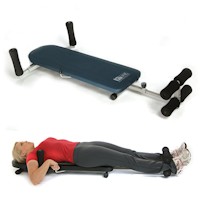 Traction & Inversion
Traction & Inversion Supports & Cushions
Supports & Cushions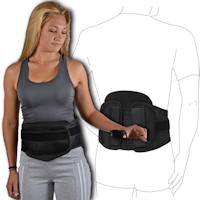 Belts & Corsets
Belts & Corsets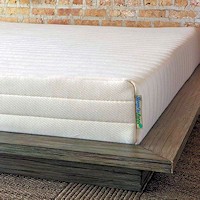 New Mattresses
New Mattresses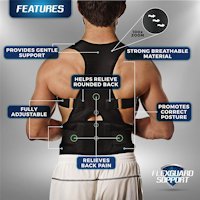 Posture Braces
Posture Braces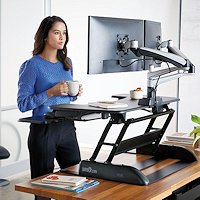 Ergonomic Aids
Ergonomic Aids